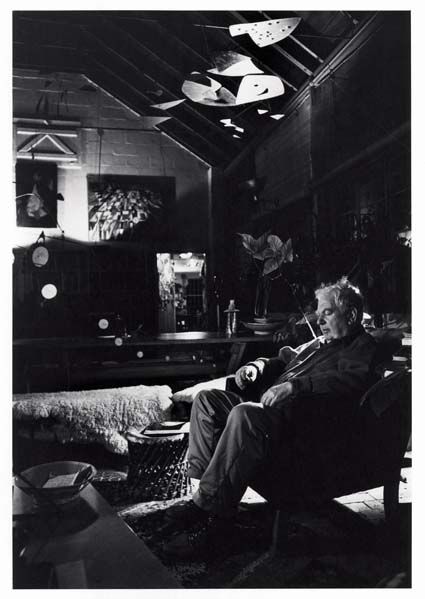Alexander Calder
“Disparity in form, color, size, weight, motion, is what makes a composition… It is the apparent accident to regularity which the artist actually controls by which he makes or mars a work.”
Rejecting the traditional notion of sculpture as grounded and static, Alexander Calder (1898–1976) experimented with volume, motion, and space. Often working with biomorphic forms in a reduced palette, he explored the natural elements that animate life. His figurative wood-and-wire sculptures, hanging kinetic mobiles, and monumental abstract works in steel and aluminum resound with mechanical ingenuity, wit, and grace.
Born to artist parents in Lawnton, Pennsylvania, Calder studied engineering before moving to New York in 1923. There, he enrolled in the Art Students League, exhibited paintings, and sketched illustrations of the Ringling Bros. and Barnum & Bailey Circus for the National Police Gazette. In 1926, he moved to Paris and created his Cirque Calder, an assemblage with which he staged performances. He began designing inventive jewelry and sculpting wire portraits, which featured in his first solo exhibition at the Weyhe Gallery in New York. In 1930, he visited the Paris studio of Piet Mondrian and was influenced to turn to total abstraction. The following year, he joined the Abstraction-Création group and created his first kinetic sculpture. His mobiles—so named by Marcel Duchamp—were propelled first by motors and later by air currents. He also made stationary works that Jean Arp dubbed stabiles.
In the 1930s, Calder relocated to Roxbury, Connecticut; he constructed sets for ballets by Martha Graham and Erik Satie as well as his first large, outdoor sculptures. During the Second World War, metal was in short supply, and he created his wood-and-wire “Constellations.” His first retrospective was mounted at the George Walter Vincent Smith Gallery in Springfield, Massachusetts in 1938, and a second followed at the Museum of Modern Art, New York, in 1943. In 1952, he represented the United States at the Venice Biennale, winning the Grand Prize for sculpture. During his lifetime, his work was also the subject of retrospectives at the Solomon R. Guggenheim Museum, New York (1964); the Museum of Fine Arts, Houston (1964); Musée National d'Art Moderne, Paris (1965);Fondation Maeght, Saint-Paul-de-Vence, France (1969); and Whitney Museum of American Art, New York (1976). In his final years, Calder focused on large-scale outdoor sculpture, working between studios in Roxbury and Saché, France. His monumental commissions include those for John F. Kennedy Airport, New York (1957); UNESCO, Paris (1958); the Olympic Games, Mexico City (1968); and the first public artwork funded by the National Endowment of the Arts, in Grand Rapids, Michigan (1969).
Exhibitions
Selected Artworks
- Alexander Calder
- Caged Stone and Fourteen Dots, c. 1948
- Sheet metal, wire, stone, rod, and paint
- 36½ × 34 × 10 inches (92.7 × 86.4 × 25.4 cm)
- Alexander Calder
- Black Beast, 1940
- Sheet metal, bolts, and paint
- 103 × 163 × 78½ inches (261.6 × 414 × 199.4 cm)
